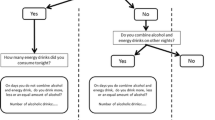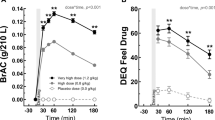Abstract
Rationale
Previously, we reported methods to estimate peak breath alcohol concentrations (BrAC) from transdermal alcohol concentrations (TAC) under conditions where alcohol consumption was controlled to produce similar BrAC levels in both sexes.
Objective
This study characterized differences in the relationship between BrAC and TAC as a function of sex and developed a model to predict peak BrAC that accounts for known sex differences in peak BrAC.
Methods
TAC and BrAC were monitored during the consumption of a varying number of beers on different days. Both men (n = 11) and women (n = 10) consumed one, two, three, four, and five beers at the same rate in a 2-h period. Sex and sex-related variables were considered for inclusion in a multilevel model to develop an equation to estimate peak BrAC levels from TAC.
Results
While peak BrAC levels were significantly higher in women than men, sex differences were not significant in observed TAC levels. This lack of correspondence was evidenced by significant sex differences in the relationship between peak TAC and peak BrAC. The best model to estimate peak BrAC accounted for sex-related differences by including peak TAC, time-to-peak TAC, and sex. This model was further validated using previously collected data.
Conclusions
The relationship between peak TAC and actual peak BrAC differs between men and women, and these differences can be accounted for in a statistical model to better estimate peak BrAC. Further studies are required to extend these estimates of peak BrAC to the outpatient environment where naturalistic drinking occurs.




Similar content being viewed by others
Abbreviations
- BMI:
-
Body mass index
- BrAC:
-
Breath alcohol concentration
- SCRAM:
-
Secure Continuous Remote Alcohol Monitor
- TAC:
-
Transdermal alcohol concentration
References
Akaike H (1998) Information theory and an extension of the maximum likelihood principle. In: Parzen E, Tanabe K, Kitagawa G (eds) Selected papers of Hirotugu Akaike. Springer, New York, pp 199–213
Ayala J, Simons K, Kerrigan S (2009) Quantitative determination of caffeine and alcohol in energy drinks and the potential to produce positive transdermal alcohol concentrations in human subjects. J Anal Toxicol 33:27–33. doi:10.1093/jat/33.1.27
Baraona E, Abittan CS, Dohmen K et al (2001) Gender differences in pharmacokinetics of alcohol. Alcohol Clin Exp Res 25:502–507. doi:10.1111/j.1530-0277.2001.tb02242.x
Barnett NP, Tidey J, Murphy JG, Swift R, Colby SM (2011) Contingency management for alcohol use reduction: a pilot study using a transdermal alcohol sensor. Drug Alcohol Depend 118:391–399. doi:10.1016/j.drugalcdep.2011.04.023
Bouchery EE, Harwood HJ, Sacks JJ, Simon CJ, Brewer RD (2011) Economic costs of excessive alcohol consumption in the U.S., 2006. Am J Prev Med 41:516–524. doi:10.1016/j.amepre.2011.06.045
Breslin FC, Kapur BM, Sobell MB, Cappell H (1997) Gender and alcohol dosing: a procedure for producing comparable breath alcohol curves for men and women. Alcohol Clin Exp Res 21:928–930. doi:10.1111/j.1530-0277.1997.tb03860.x
Carey KB, Scott-Sheldon LAJ, Carey MP, DeMartini KS (2007) Individual-level interventions to reduce college student drinking: a meta-analytic review. Addict Behav 32:2469–2494. doi:10.1016/j.addbeh.2007.05.004
Cartier A, Côté M, Lemieux I, Pérusse L, Tremblay A, Bouchard C, Després JP (2009) Sex differences in inflammatory markers: what is the contribution of visceral adiposity? Am J Clin Nutr 89:1307–1314. doi:10.3945/ajcn.2008.27030
CDC (Centers for Disease Control) (2011) Excessive alcohol use: addressing a leading risk for death, chronic disease, and injury: at a glance 2011. http://www.cdc.gov/chronicdisease/resources/publications/aag/alcohol.htm. Accessed 3 June 2013
CDC (Centers for Disease Control) (2012) Fact sheets—alcohol use and health. Accessed on April 29, 2013 at http://www.cdc.gov/alcohol/fact-sheets/alcohol-use.htm.
de Visser RO, Birch JD (2012) My cup runneth over: young people's lack of knowledge of low-risk drinking guidelines. Drug Alcohol Rev 31:206–212. doi:10.1111/j.1465-3362.2011.00371.x
Del Boca FK, Darkes J (2003) The validity of self-reports of alcohol consumption: state of the science and challenges for research. Addiction 98:1–12. doi:10.1046/j.1359-6357.2003.00586.x
Dettling A, Fischer F, Bohler S et al (2007) Ethanol elimination rates in men and women in consideration of the calculated liver weight. Alcohol 41:415–420. doi:10.1016/j.alcohol.2007.05.003
Devos-Comby L, Lange JE (2008) Standardized measures of alcohol-related problems: a review of their use among college students. Psychol Addict Behav 22:349–361. doi:10.1037/0893-164X.22.3.349
Dougherty DM, Charles NE, Acheson A, John S, Furr RM, Hill-Kapturczak N (2012) Comparing the detection of transdermal and breath alcohol concentrations during periods of alcohol consumption ranging from moderate drinking to binge drinking. Exp Clin Psychopharmacol 20:373–381. doi:10.1037/a0029021
First MB, Spitzer RL, Givvon M, Williams JBW (2001) Structured clinical interview for DSM-IV-TR Axis I Disorders, Research Version, Non-patient Edition (SCID-I/NP). Biometrics Research, New York State Psychiatric Institute, New York
Giacomoni PU, Mammone T, Teri M (2009) Gender-linked differences in human skin. J Dermatol Sci 55:144–149. doi:10.1016/j.jdermsci.2009.06.001
Hahn JA, Woolf-King SE, Muyindike W (2011) Adding fuel to the fire: alcohol's effect on the HIV epidemic in Sub-Saharan Africa. Curr HIV/AIDS Rep 8:172–180. doi:10.1007/s11904-011-0088-2
Hattori K, Okamoto W (1993) Skinfold compressibility in Japanese university students. Okajimas Folia Anat Jpn 70:69–77
Hattori K, Numata N, Ikoma M, Matsuzaka A, Danielson RR (1991) Sex differences in the distribution of subcutaneous and internal fat. Hum Biol 63: 53-63. Retrieved from http://www.jstor.org/stable/41464142?origin=JSTOR-pdf
Helander A, Peter O, Zheng Y (2012) Monitoring of the alcohol biomarkers PEth, CDT and EtG/EtS in an outpatient treatment setting. Alcohol Alcohol 47:552–557. doi:10.1093/alcalc/ags065
Jacobi U, Gautier J, Sterry W, Lademann J (2005) Gender-related differences in the physiology of the stratum corneum. Dermatology 211:312–317. doi:10.1159/000088499
Javors MA, Johnson BA (2003) Current status of carbohydrate deficient transferrin, total serum sialic acid, sialic acid index of apolipoprotein J and serum beta-hexosaminidase as markers for alcohol consumption. Addiction 98:45–50. doi:10.1046/j.1359-6357.2003.00582.x
Jones BM, Jones MK (1976) Alcohol effects in women during the menstrual cycle. Ann N Y Acad Sci 273:576–587. doi:10.1111/j.1749-6632.1976.tb52931.x
Kerr WC, Stockwell T (2012) Understanding standard drinks and drinking guidelines. Drug Alcohol Rev 31:200–205. doi:10.1111/j.1465-3362.2011.00374.x
Leffingwell TR, Cooney NJ, Murphy JG et al (2013) Continuous objective monitoring of alcohol use: twenty-first century measurement using transdermal sensors. Alcohol Clin Exp Res 37:16–22. doi:10.1111/j.1530-0277.2012.01869.x
Liu J, Fox CS, Hickson DA, May WD, Hairston KG, Carr JJ, Taylor HA (2010) Impact of abdominal visceral and subcutaneous adipose tissue on cardiometabolic risk factors: the Jackson Heart Study. J Clin Endocrinol Metab 95:5419–5426. doi:10.1210/jc.2010-1378
Marques PR (2012) Levels and types of alcohol biomarkers in DUI and clinic samples for estimating workplace alcohol problems. Drug Test Anal 4:76–82. doi:10.1002/dta.384
Marques PR, McKnight AS (2007) National Highway Traffic Safety Administration. Evaluating transdermal alcohol measuring devices (report no. DOT HS 810 875). US Government, Washington
Marques PR, McKnight AS (2009) Field and laboratory alcohol detection with 2 types of transdermal devices. Alcohol Clin Exp Res 33:703–711. doi:10.1111/j.1530-0277.2008.00887.x
Marques P, Tippetts S, Allen J et al (2010) Estimating driver risk using alcohol biomarkers, interlock blood alcohol concentration tests and psychometric assessments: initial descriptives. Addiction 105:226–239. doi:10.1111/j.1360-0443.2009.02738.x
Mokdad AH, Marks JS, Stroup DF, Gerberding JL (2004) Actual causes of death in the United States, 2000. J Am Med Assoc 291:1238–1245. doi:10.1001/jama.291.10.1238
Nakagawa S, Schielzeth H (2013) A general and simple method for obtaining R 2 from generalized linear mixed-effects models. Methods Eco and Evol 4:133–142. doi:10.1111/j.2041-210x.2012.00261.x
National Institute of Alcohol Abuse and Alcoholism (NIAAA) (2004) National Institute of Alcohol Abuse and Alcoholism Council approves definition of binge drinking. NIAAA Newsletter, no. 3. http://pubs.niaaa.nih.gov/publications/newsletter/winter2004/newsletter_number3.pdf Accessed 3 June 2013
National Institute of Alcohol Abuse and Alcoholism (NIAAA) (2014) Moderate and binge drinking. Accessed on May 1, 2013 at http://www.niaaa.nih.gov/alcohol-health/overview-alcohol-consumption/moderate-binge-drinking.
Rehm J, Gmel G, Sempos CT, Trevisan M (2003a) Alcohol-related morbidity and mortality. Alcohol Res Health 27:39–51
Rehm J, Room R, Graham K, Monteiro M, Gmel G, Sempos CT (2003b) The relationship of average volume of alcohol consumption and patterns of drinking to burden of disease: an overview. Addiction 98:1209–1228. doi:10.1046/j.1360-0443.2003.00467.x
Sakai JT, Mikulich-Gilbertson SK, Long RJ, Crowley TJ (2006) Validity of transdermal alcohol monitoring: fixed and self-regulated dosing. Alcohol Clin Exp Res 30:26–33. doi:10.1111/j.1530-0277.2006.00004.x
Sandby-Møller J, Poulsen T, Wulf HC (2003) Epidermal thickness at different body sites: relationship to age, gender, pigmentation, blood content, skin type and smoking habits. Acta Derm Venereol 83:410–413. doi:10.1080/00015550310015419
Sobell LC, Sobell MB (2003) Alcohol consumption measures. In: Allen JP, Columbus M (eds) Assessing alcohol problems: a guide for clinicians and researchers, 2nd edn. National Institute on Alcohol Abuse and Alcoholism, Rockville, pp 77–99
Swift R (2000) Transdermal alcohol measurement for estimation of blood alcohol concentration. Alcohol Clin Exp Res 24:422–423. doi:10.1111/j.1530-0277.2000.tb02006.x
Swift R (2003) Direct measurement of alcohol and its metabolites. Addiction 98:73–80. doi:10.1046/j.1359-6357.2003.00605.x
Swift RM, Martin CS, Swette L, LaConti A, Kackley N (1992) Studies on a wearable, electronic, transdermal alcohol sensor. Alcohol Clin Exp Res 16:721–725. doi:10.1111/j.1530-0277.1992.tb00668.x
Tur E (1997) Physiology of the skin—differences between women and men. Clin Dermatol 15:5–16. doi:10.1016/S0738-081X(96)00105-8
Wechsler H, Nelson TF (2001) Binge drinking and the American college student: what's five drinks? Psychol Addict Behav 15:287–291. doi:10.1037/0893-164X.15.4.287
Westerbacka J, Cornér A, Tiikkainen M, Tamminen M, Vehkavaara S, Häkkinen AM, Fredriksson J, Yki-Järvinen H (2004) Women and men have similar amounts of liver and intra-abdominal fat, despite more subcutaneous fat in women: implications for sex differences in markers of cardiovascular risk. Diabetologia 47:1360–1389. doi:10.1007/s00125-004-1460-1
White AM, Kraus CL, McCracken LA, Swartzwelder HS (2003) Do college students drink more than they think? Use of a free-pour paradigm to determine how college students define standard drinks. Alcohol Clin Exp Res 27:1750–1756. doi:10.1097/01.ALC.0000095866.17973.AF
Acknowledgments
Research reported in this publication was supported by the National Institute on Alcohol Abuse and Alcoholism of the National Institutes of Health [R01AA14988]. The research was also supported in part by the National Institute of Drug Abuse [T32DA031115] for postdoctoral training for Tara E. Karns. The content is solely the responsibility of the authors and does not necessarily represent the official views of the National Institutes of Health. Dr. Dougherty also gratefully acknowledges support from a research endowment, the William and Marguerite Wurzbach Distinguished Professorship. The authors appreciate the supportive functions performed by our valued colleagues Cameron Hunt and Krystal Shilling.
Conflict of interest
None of the authors have conflicts of interests concerning this manuscript.
Author information
Authors and Affiliations
Corresponding author
Rights and permissions
About this article
Cite this article
Hill-Kapturczak, N., Roache, J.D., Liang, Y. et al. Accounting for sex-related differences in the estimation of breath alcohol concentrations using transdermal alcohol monitoring. Psychopharmacology 232, 115–123 (2015). https://doi.org/10.1007/s00213-014-3644-9
Received:
Accepted:
Published:
Issue Date:
DOI: https://doi.org/10.1007/s00213-014-3644-9




